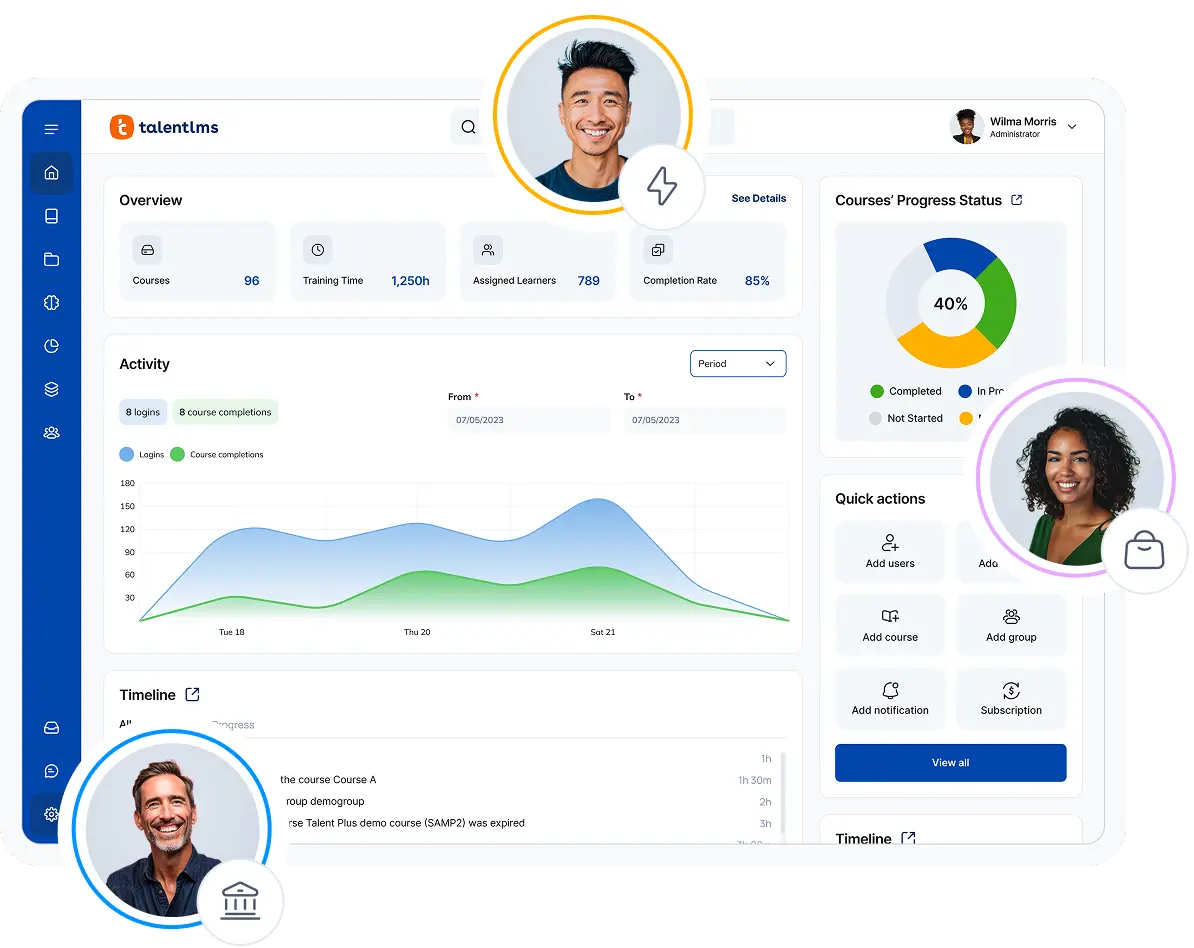- What is employee wellbeing?
- Why is employee wellbeing important?
- What are the challenges of wellness programs and initiatives in organizations?
- What are the 4 elements of employee wellbeing?
- How to improve employee wellbeing
- Best practices for building effective employee wellbeing programs
- How to measure employee wellbeing
- The role of managers in employee wellbeing
- Build a strong foundation for employee wellbeing
Supporting employee wellbeing matters. It’s not just some fluffy HR concept—it has real benefits for both your people and your business.
Picture this: your employees are burnt out, disengaged, and their productivity is plummeting. Stress levels are rising, and morale is in a nosedive. The toll this takes on your business isn’t just about decreased productivity—it’s about increased turnover, low employee engagement, and a potentially toxic work environment.
The real kicker? This is all preventable with a serious focus on employee wellbeing.
In this article, we’ll look at why supporting employee wellbeing is so important. Plus, we’ll give you three actionable ways to boost employee wellbeing at your organization.
What is employee wellbeing?
Employee well-being refers to workers’ physical, mental, and emotional health. It includes job satisfaction, financial security, better work-life balance, social well-being, and overall comfort in the workplace.
Effective employee health and wellbeing initiatives address these dimensions holistically, recognizing that they are interconnected and influence one another. For example, financial stress can impact mental health, which in turn can influence physical wellbeing and job performance.
There are two major ways companies affect employee wellbeing:
- One of these is how the company supports its employees. An example is using a flexible work schedule so that your employees can get some rest and avoid burnout.
- The other one is how your company affects employees, both during and outside of work. For example, a change in how the company works could make people feel more stressed, which might make them do less and be less happy.
Why is employee wellbeing important?
Employee well-being is not just a bonus; it also has a number of benefits for both employees and organizations.
Increases employee retention and attracts top talent
Beyond the obvious key metrics they drive, helping employees with their wellbeing creates a positive work culture. When employees feel valued and cared for, they are more likely to be loyal and committed to their company. This, in turn, raises the company’s brand reputation as an employer of choice, attracting top talent and helping employee retention.
One study found burnout makes workers nearly 3.4 times more likely to start looking for a new job. The same report found that 42% of employees were experiencing burnout at the end of 2022. Solving this could help your team stay more committed, motivated, and prepared.
Enhances brand reputation
Taking care of employees is not just about the immediate benefits—it also helps build a solid brand image for an employer. In this way, you not only retain and attract top talent, but also build a positive culture around your brand which can also boost customer engagement.
Sparks innovation and boosts employee productivity
Innovation and productivity thrive in environments where employees feel secure and valued. When employees are not bogged down by stress and burnout, they also have the mental space to focus better, think creatively, and take risks.
Google’s renowned 20% time policy, where employees spend 20% of their time on projects they’re passionate about, is a testament to this. Google helps create a space where employees can be creative and innovative by giving them time to learn and apply new skills.
Promotes resilience and improved morale
Companies that care about their employees’ mental health have a more resilient workforce and experience real employee engagement. Supporting wellbeing at work creates a thriving workforce and helps businesses achieve sustainable long-term growth.
What are the challenges of wellness programs and initiatives in organizations?
One of the biggest challenges businesses often face is low employee engagement. Despite the best intentions, many wellness initiatives fail to resonate with the workforce, leading to low participation rates and impact.
Another common pitfall is the tendency to adopt a one-size-fits-all approach. Every organization is unique with diverse employee needs. A generic wellness program that doesn’t account for these is unlikely to yield the desired results.
Limited resources can also hinder the success of wellbeing initiatives. To create programs that deal with physical, mental, emotional, and financial wellness, you need a lot of money and dedicated people.
In addition, assessing the effectiveness of wellness programs in terms of return on investment (ROI) can be a challenging task. While it’s clear that a healthier, happier workforce is good for the company, it can be hard to measure how it moves the needle.
What are the 4 elements of employee wellbeing?
Employee wellbeing is a complex concept that covers numerous facets of an individual’s life. Employers need to understand these different parts to create an effective wellness program for their employees.
Let’s review employee wellbeing through these five elements:
1. Physical health and wellbeing
Physical wellbeing comes down to a person’s overall physical health and fitness. It is influenced by factors like proper nutrition, regular exercise, adequate sleep, and preventive healthcare measures.
Employees with good physical health will feel more energetic, work better, and be less absent because of sickness.
2. Mental and emotional wellbeing
Mental health and emotional wellbeing depend on a person’s psychological and emotional state. A solid foundation helps manage things like stress, anxiety, hybrid work ambiguity, and depression. It also helps you feel good and have a sense of purpose.
Employees with strong emotional and mental health can focus better, make better choices, and have healthier relationships with their peers.
3. Financial wellbeing
Financial health is all about how you manage your money and plan for the future. It includes things like budgeting, saving, investing, and planning for retirement.
Addressing financial wellbeing can reduce stress and anxiety related to financial concerns. It’s often an overlooked aspect but essential in improving employee wellbeing.
4. Social wellbeing
Social wellbeing means how well a person connects with others and feels like they belong in their social networks at work and in their personal life.
Good social skills and habits can lead to improved collaboration, teamwork, and higher employee morale.
How to improve employee wellbeing
There are many options open to employers who want to help improve employee wellbeing.
Provide training to boost employee wellbeing
Training is important for creating a culture that values employee health and happiness.
According to the TalentLMS research on upskilling and reskilling, 71% of employees are eager to learn new things. And this not only helps employee engagement but also supports employee wellness.
But, aside from ongoing employee training, you should train for personal development and wellbeing.
Here are some ideas:
- Assign relevant wellbeing training topics on the company LMS.
- Organize fitness challenges, such as step competitions or team-based workout programs.
- Offer mindfulness meditation sessions such as guided meditation, breathing exercises, or yoga classes during work hours.
- Establish healthy eating programs such as access to nutritious snacks at the office.
These methods can help employees manage stress, improve health and overall wellbeing—all essential for employee mental health.
Introduce an Employee Assistance Program
An Employee Assistance Program (EAP) is a full-service wellbeing program that helps employees in many ways.
EAPs are mostly used for counseling. Employees can talk to licensed professionals about their problems and get valuable solutions.
In addition to counseling, many EAPs offer legal and financial assistance services. Employees can talk to lawyers or financial experts to get help with issues like divorce, debt management, and budgeting.
EAPs can also give employees advice and referrals for other things that can improve their wellbeing, like helping with parental duties, promoting physical health, or even offering career wellbeing advice.
These services offer mental health benefits that positively impact employee wellbeing at work.
Embrace flexible work arrangements
For many employees, workplace wellbeing is all about a healthy work-life balance. So, flexible work arrangements help employees feel more satisfied with their jobs.
Organizations should leverage this flexibility to boost employee wellbeing.
Flexible schedules, like flextime or shorter workweeks, let employees choose how they work according to their needs and the best times of day. Some people may want to start their day earlier and leave earlier. Others might choose a later start time to accommodate family responsibilities or personal preferences.
Flexible work arrangements make employees happier and help create trust and independence within the company. When employees feel free to manage their time and tasks well, they are more likely to be more productive and committed to their employer.
Best practices for building effective employee wellbeing programs
Successful employee wellbeing programs have been around for ages and along with it, some best practices have emerged.
Take a holistic approach to improving wellbeing
Effective wellbeing programs should address multiple dimensions of wellness, including physical, mental, emotional, financial, and social aspects. A holistic approach that caters to the diverse needs of employees is more likely to resonate and drive positive outcomes.
Create a personalized employee wellbeing program
Take into account that employees have different needs, preferences, and goals when it comes to wellbeing at work. You’ll want to offer a range of personalized options and resources to cater to their wellbeing journey. For example:
- For remote workers, focus on virtual wellness offers or mental health services that meet their needs.
- For a global workforce, you could offer employees company benefits such as health insurance plans based on their location.
- For working parents or caretakers in your company, you could offer flexible working schedules or additional time off to facilitate their personal responsibilities.
Introducing employee wellbeing initiatives is a good way to ensure you’re supporting employee wellness.
Sprinkle in some incentive and recognition
Employee recognition is also a great way to help employees feel good and proud about their work, further incentivizing and motiving them.
Motivate and encourage employees by rewarding and praising them for better job performance. This could include rewards or public acknowledgment of achievements. Our employee appreciation survey shows that employees feel recognized when they are rewarded with:
- Bonuses
- Paid time off
- Gifts
- Training
- Public recognition of efforts
So, a few employee recognition ideas include:
- Bonus schemes related to performance
- Paid time off for birthdays, volunteer programs, or employee appreciation day
- Ongoing training opportunities
- Shoutouts in team meetings or company all-hands
Be prepared to face resistance
Sometimes, employees might not even be aware that they need to improve their wellbeing at work. Whatever their reason, it is going to take some patience and planning to overcome this.
Clear communication, training, and support are key for a smooth transition and long-term adoption.
To create a mindfulness training program, for individuals or teams, Gina Lionatos, Brand Marketing Manager at TalentLMS, shares some quick tips:
TalentLibrary – Skills that matter, courses that deliver
With TalentLibrary, you set the foundation for a strong, aligned workforce—soft skills, compliance, and workplace essentials, from day one (and beyond).
How to measure employee wellbeing
Implementing an employee wellbeing strategy is an investment in your workforce that you will want to keep track of.
When talking about measuring anything, there are two key questions: how and what.
‘How’ consists of the methods used for gathering feedback and data, while ‘what’ is focused around the specific metrics to track.
In terms of methods, you’ll want to try a combination of the following:
- Employee surveys are one of the most direct ways to gauge employee wellbeing. These surveys can cover various aspects, including job satisfaction, work-life balance, employee stress levels, and overall well-being.
- Focus groups are more engaging and require a more thorough approach to gathering feedback. While highly effective, they can take time and sometimes be skewed by unconscious bias.
- One-on-one interviews offer a personalized approach to understanding employee wellbeing. These conversations can uncover employee concerns and act as a safe space for employees to share their thoughts and feelings.
- Data analytics tools can help you track and analyze various metrics related to employee wellbeing. These tools help to monitor trends and find problem areas.
In terms of key metrics to monitor, a few key ones to look into are:
- Absenteeism rates. Track the number of unplanned absences and compare them to pre-initiative levels to see if the employee wellbeing program has reduced absenteeism.
- EAP usage. Monitor the usage of your EAP services, which can reveal trends in the types of support employees are seeking.
- Retention and turnover rates. Low employee wellbeing often contributes to high turnover. Analyze exit interviews and turnover data to identify potential wellbeing issues.
- Productivity levels. Measure employee productivity by examining things like the number of tasks they complete, the number of sales deals they close, or the length of projects to see if wellness programs are helping them focus and perform better.
- Healthcare costs. Look at the organization’s healthcare spending to see if preventive measures and wellness programs are helping to lower overall healthcare costs.
The role of managers in employee wellbeing
Managers play a significant role on employee wellbeing in the workplace. They are very important in making sure employees are happy and healthy at work.
A good manager can transform workplaces and employee wellbeing, while a poor management style can be catastrophic for employee morale and mental health.
For example, by using open communication, they can identify and address wellbeing issues before they fester. They can build trust and build positive relationships with their team by being empathetic and caring. They give clear expectations and regular feedback to help employees feel secure and understood.
But how can managers learn to improve wellbeing and create a positive work environment for their team? Through training.
Training equips managers with the tools to recognize signs of stress, understand different personalities, and learn effective communication strategies. Programs on emotional intelligence, conflict resolution, and active listening can make a world of difference in helping them take care of their employees’ wellbeing.
Build a strong foundation for employee wellbeing
A truly successful employee wellbeing program is more than just a collection of initiatives—it’s a strategic approach intended to promote wellbeing and boost employee engagement at every level.
TalentLMS—a full-spectrum employee training software—gives you a robust platform to support employee wellbeing and foster a positive company culture.
You can use it to create engaging training modules that cover physical health, mental wellness, stress management, and work-life balance. These courses should be designed to be both informative and actionable, offering practical strategies that can be easily integrated into daily life.
You can also use it to build courses to support managers in their role as wellbeing champions. By teaching how to prevent workplace stress, you can prepare managers to create a supportive environment.
By doing so, you’ll create a healthy workplace culture for everyone.
Ready to build a foundation for wellbeing with TalentLMS? Sign up here.
Originally published on: 01 Feb 2021 | Tags: Employee Engagement,Employee Wellbeing





